RECOGNISING THE CHARACTER OF A PUBLIC PLACE
ACKNOWLEDGE THE RELATION BETWEEN SOCIO CULTURAL, ECONOMIC & ENVIRONMENTAL ASPECTS OF GODAVARI GHATS IN NASHIK
Jidnyesh Sawardekar | jidnyesh08@gmail.com
ABSTRACT
The transition from private to social interaction is where the character of a public place starts showing up. Any public place could be visualised in three distinct characteristics; such as commercial, social, and environmental activities. The nature of activities could be easily captured with these aspects, giving an overall idea of how the place functions. The study of Godavari Ghats in the core area of Nashik allows for recognising the soul character of such a public place in an urban context with a unique identity. Activities are divided into three aspects of sociocultural, economic, and environmental features to understand the role of each and the interdependency between them.
KEY WORDS Public place, Inclusive, Temples, Visual connectivity, River edge
INTRODUCTION
A public place is where a gathering happens on a soul level. Individuals transit their boundaries from private space to common space, shared by multiple people where interaction happens. Such area has a transitional character with flexible boundaries. The term public place gets more refined as the character of space changes from private to public.
Godavari Ghats is a living example of an urban public place which has developed over time. The recent character of the Ghats has been evolving over the past 400 years. Some temples and structures dating back to the 1800s are still present.
1
METHODOLOGY
The following research recognises the character of a public place on a micro level. The method follows colour denotation for each particular aspect mentioned above, showing views and photos of the place in graphical format which makes effortless visual understanding of these aspects and the interrelation between them.
‘
SOCIO CULTURAL ECONOMIC ENVIRONMENTAL NEUTRAL
Legend 1 Colour coding for Methodology | Source: Author
Legend 1’ showsthecolourcodingandthedescriptionforthesame. The socio cultural, economic and environmental features are divided to grasp the character visually. It helps to recognise the character of Godavari Ghats by studying the role of each of these aspects and the interaction or interdependency between these.
Socio cultural aspects highlight the heritage of the old city, religious & spiritual importance the temples and the Ghats, devotees, visitors, tourists and the local people. Economic boundaries show the commercial activity which includes shops and vendors. Environmental character recognizes the Godavari River, Trees and other green spaces. Neutral colour represents an area outside of consideration which is mainly residential buildings on the river edge.
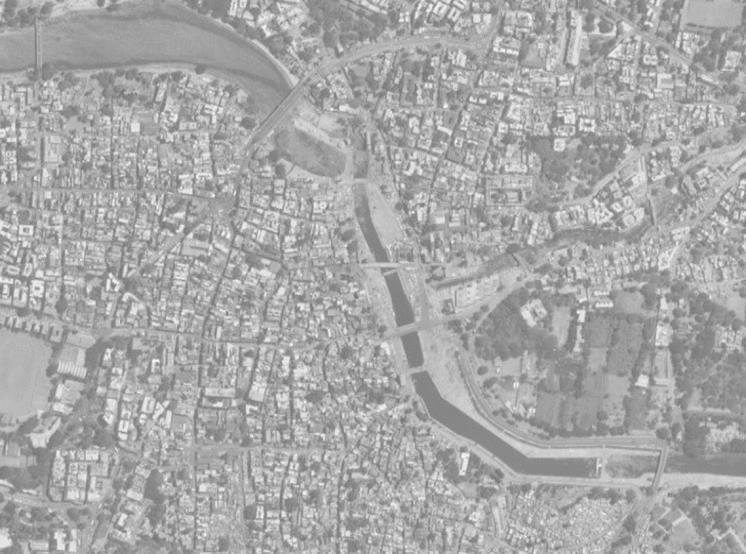









AREA OF STUDY
The Godavari River starts its journey from the Trimbakeshwar in Nashik district located on the western side of the city. Any river travelling through the city affects the surrounding river edge. Ghats were constructed on any river primarily to protect the river edge from losing its form. Ghats allowed the riverfront to develop, making every edge into a large public place where temples were the central aspect.
2
PANCHAWATI
OLD CITY
Figure 1 Area of Study (Location) | Image Source: Google Maps
LEGEND:
Gandhi Lake
Ramkund
Goraram Temple
Balaji Temple
Sardar Chowk
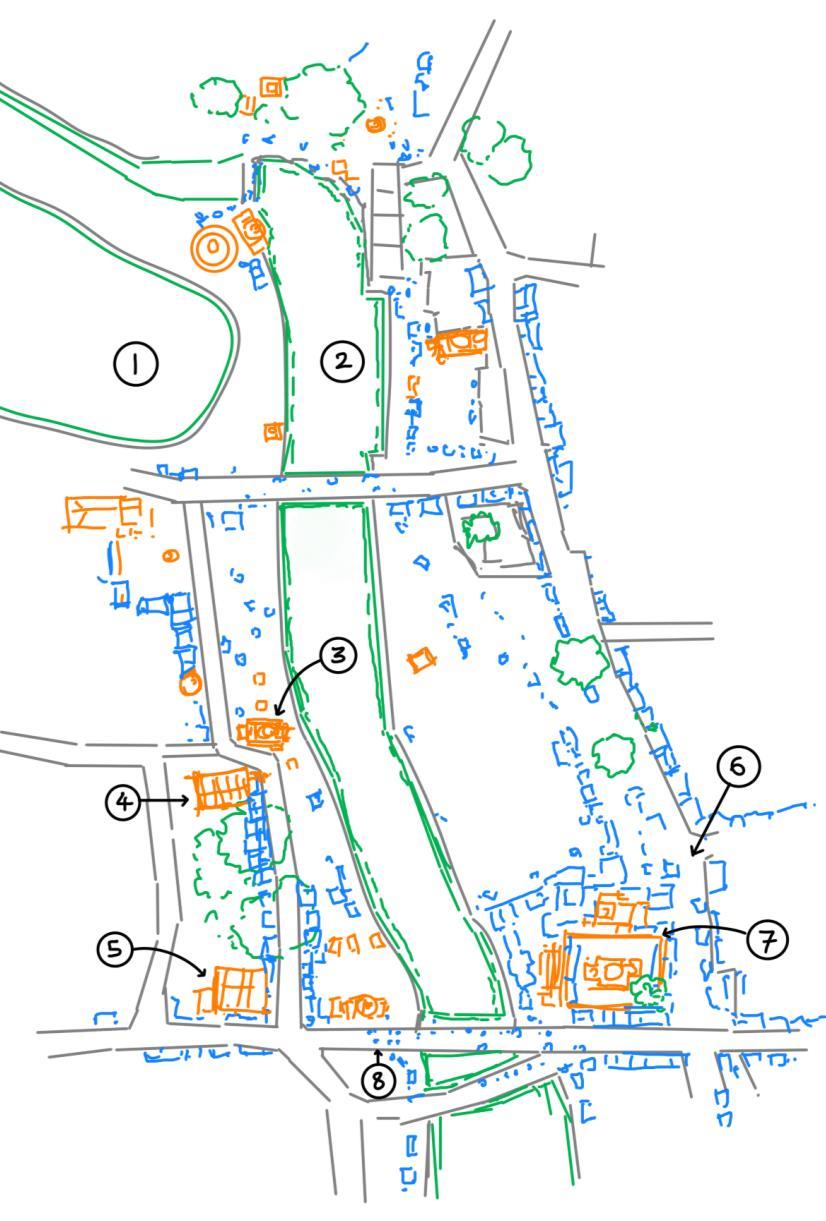
Naroshankar Temple
Ram-Setu Bridge
Godavari river takes its southern turn while entering the city, making the flow of the river calm. Around 800 m south the river turns again towards the eastern side making a north south stretch which is the active space of Ghats. In Hindu mythology, Nashik has great religious importance. It is believed that during his exile, Lord Ram took shelter in a cave located on the eastern side of the river Godavari. The eastern side known as Panchawati.
3
1.
2.
3.
4.
5.
6.
7.
Figure 2 Colour coded plan of study area | Source: Author 8.
Mahadev Temple
OBSERVATION AND MAPPING
Devotees, mainly local people, visit temples in the surrounding area of Ghats on a daily basis for worship, making it the primary activity of ghats in the morning. Most of the rituals happen in the area of Ramkund which is surrounded by many temples and a common dome structure which is constructed as a gathering shelter. This area is mostly active during Poornima and Ekadashi when pilgrims and visitors from outside of the city come in large numbers.
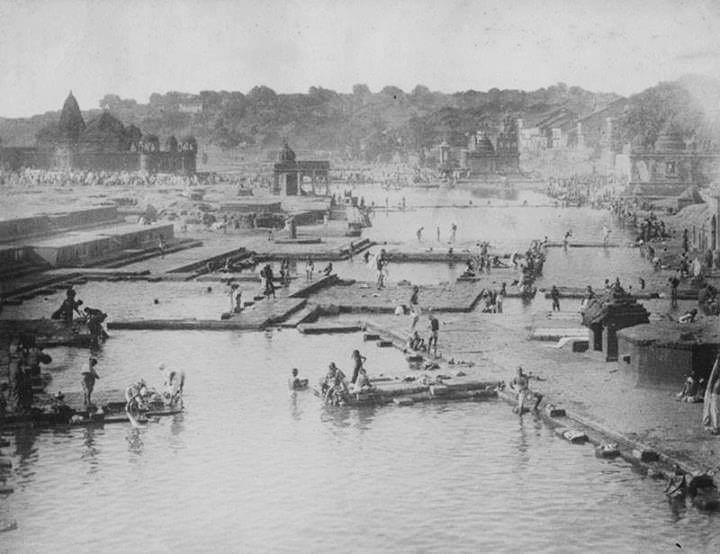

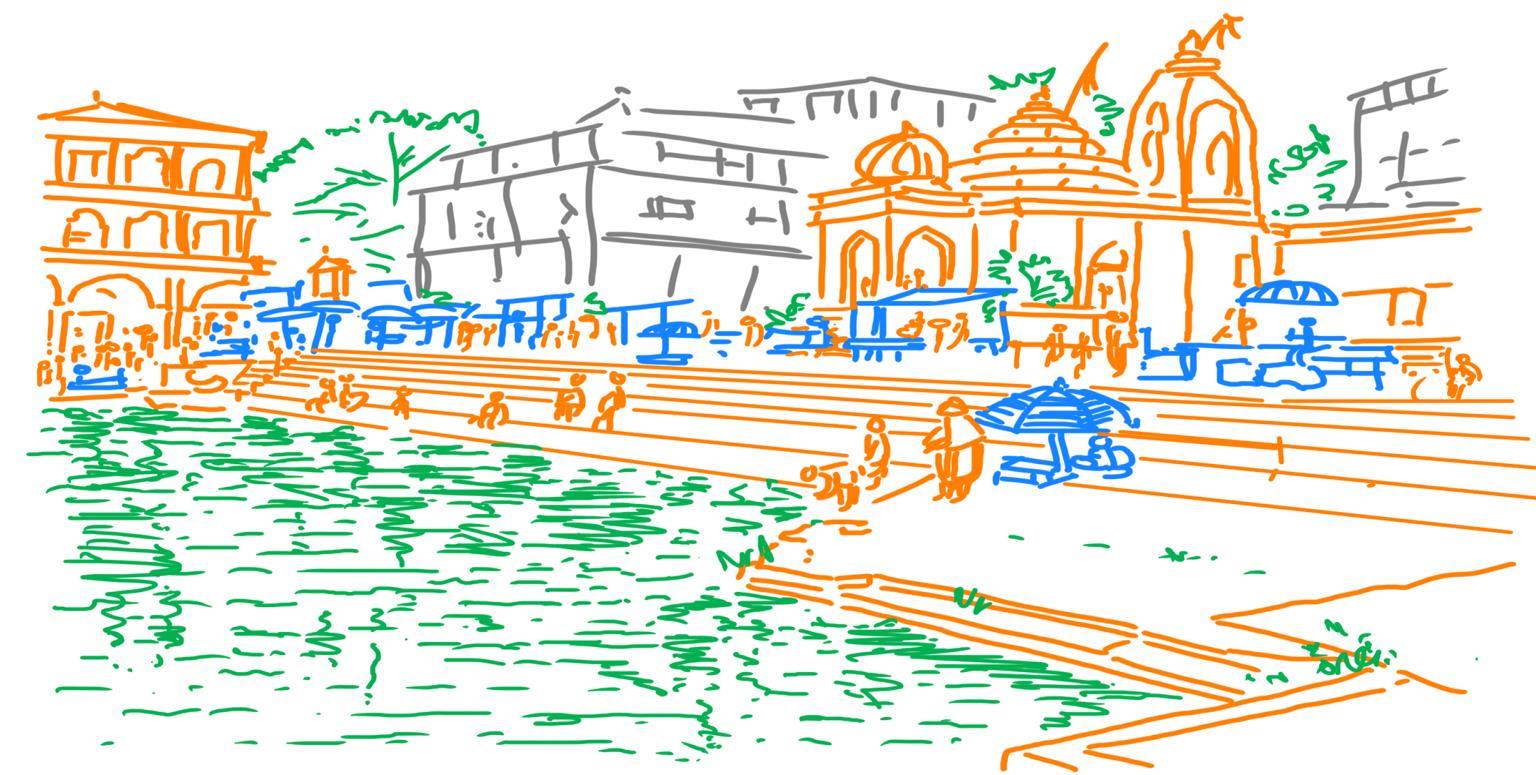
4
Figure 5 Ram Kund: Eastern edge (Pa nchawati) | Source: Author
Figure 3 Ghats in 1900’s| Source: https:// justnashik.com Figure 4 Ghats in today’s date | Source: Author
The very edge of the river has a purpose where people could access the river for rituals from steps. This long strip running along the river serves the casual activity of people to sit and relax and makes strong interaction between both sides of the river. Steps also create a downward direction on both sides and give inclusive character to Ghats with the river visual centre.
The second most active space is the Naroshankar and Devi temple and the surrounding area including Sardar chowk (Figure 6). The nature of activity here is majorly commercial as shops and vendors have developed around. Devi temple is observed to be flooded with devotees, mainly local people.
The commercial activity in this area is entirely related to religious and ritual needs. All these shops and vendors are dependent on visitors coming to the temple. As we move towards the market area, Sardar Chowk shows other shops related to daily needful, copper and brass ornaments, eateries etc.
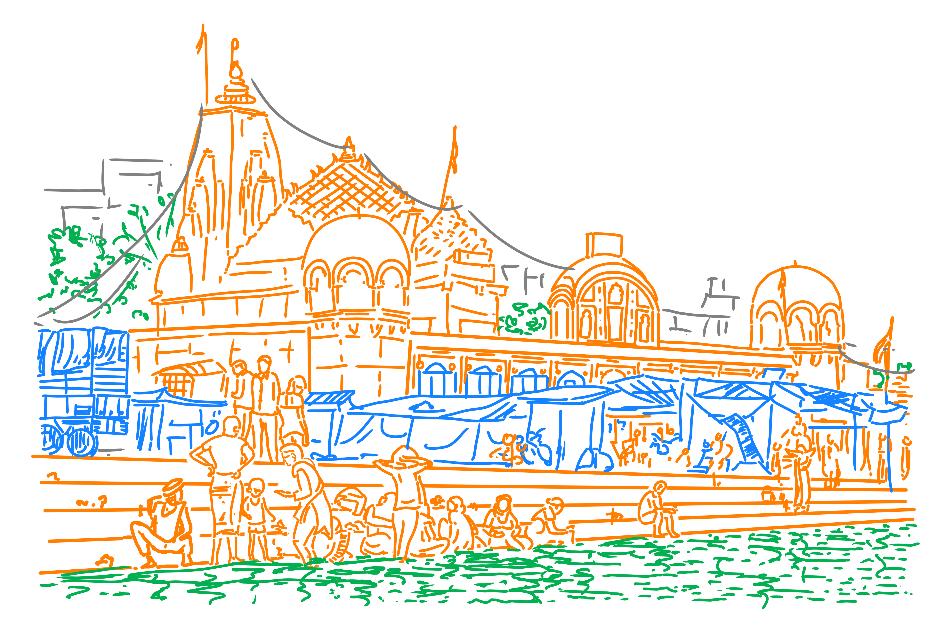
5
Figure 6 Naroshankar Temple and surroundings | Source: Author
A


6 AM TO 10 AM & 1 PM TO 4 PM
B 10.30 AM TO 12 NOON & 5 PM TO 7 PM
Figure 7 Plan of Naroshankar, Devi Temple and surrounding shops | Source: Author
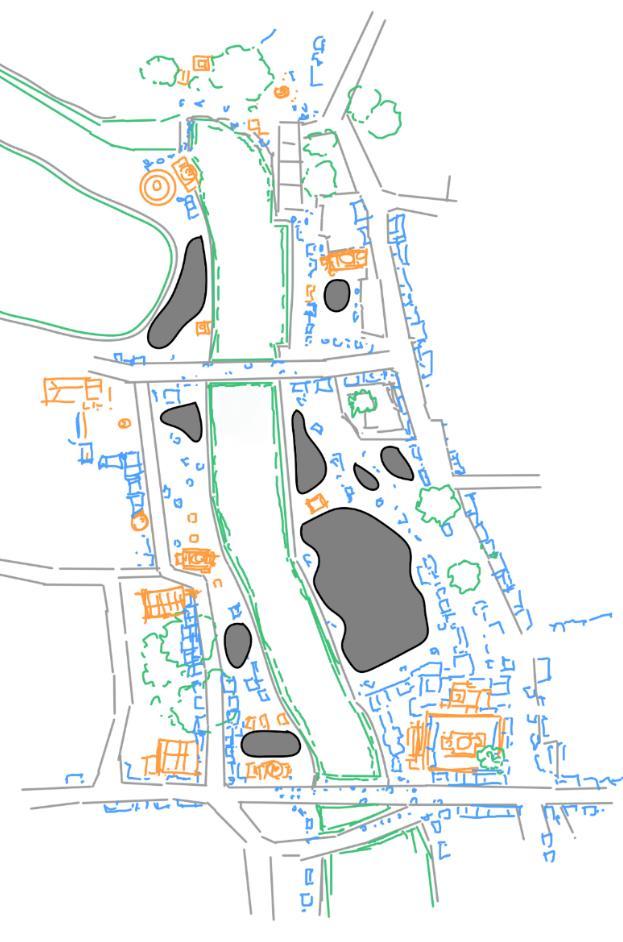

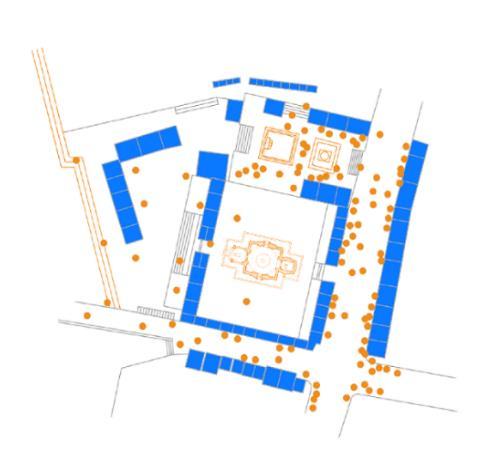
The plan in ‘figure 7’ is showing people accessing Naroshankar and Devi temple during different times of the day. ‘A’ showing fewer active times during the early morning and mid-afternoon. ‘B’ shows the most active times are 10.30 to 12 in the morning and 5 to 7 in the evening. A linear arrangement of socio cultural and economic aspects could be seen parallel to the river which is an environmental character. Commercial activity primarily happens along the river intervening between the river edge and the street. This long strip of commercial activity along has several breakpoints such as nodes and empty spaces. The Focus points between these strips where major activity gets attracted are temples. The openness of the entire riverfront area neutralises the chaotic environment of market streets along the river.
Figure 8 Dead Open Spaces | Source: Author
6
Some spaces have been built for large gatherings such as Gudhi Padwa, and Kumbh Mela becomes dead open patches with a lack of any activity (Figure 8). Some of these spaces are used for parking creating large parking patches middle of river edge and streets. It is observed that a lack of focal points where people and commercial activity could get attracted causes such dead spaces to form. Another aspect of these spaces is that they are the keen reason of visual connectivity without any disturbance over such a long span of Ghats.
CONCLUSION
ENVIRONMENT- A CORE ASPECT
The Godavari River which is the lifeline of Nashik, is the source of the city, from the beginning to enrichment and development. Cities grown around rivers have specific development patterns creating rivers as the centre point of social and economic activities. Godavari Ghats emits the quality of being the heart of Nashik City. The number of trees is very less; each tree has recognised by the surrounding space, which could be a temple, small shrine, shop or even a particular vendor sitting under that tree.
INTERDEPENDENCY OF SOCIAL, CULTURAL AND COMMERCIAL ACTIVITIES
Entire schemes of activities irrespective of their nature are getting performed parallel to the river edge. The river has become directory path through major street networks are perpendicular to Ghats and gives access to the public area of Ghats from all sides.

7
Figure 9 Section from Naroshankar Temple and Godavari River showing north side, Ram Kund and surrounding spaces | Source: Author
Social Activity is independent of commercial activity but not vice versa. All shops and vendors are dependent on spaces with the peak of footfall such as Ghats edge and temple entrances. Temples have been the soul of the cities from the past in India where any temple becomes a centre point of activity in any locality. Godavari Ghats have a Parallel running edge with recognisable cultural and religious landmarks such as temples, Samadhi mandir and small shrines. Secondary streets coming from the surrounding city merge with the street or open space running parallel to the river. Naturally, people tend to come to Ghats daily for various reasons including temple visits and refreshments around the river. Commercial activity flourished naturally around the active areas of nodes intersecting streets, temple surroundings, and bridges connecting two active nodes on either side of the river.
INCLUSIVENESS - THE FUNDAMENTAL CHARACTER
Any public place shows the central space which is the soul area from which all the activities are further segregated such as a courtyard, atrium, open ground, lake or river as well. This core space is the fundamental space of any public place which binds the entire set of smaller divisions of activities into one.
The public place itself suggests an inclusive nature of activities which is clearly visible at Godavari Ghats which is a naturally grown public place with no defined boundaries. Parallel activity leads to minimising the junctions and divisions of spaces, which gives Ghats its identity and unique character of an inclusive place where all the activities from the micro level are visually connected for the entire stretch of Ghats, which acts as a single public place.
8
REFRENCES
1) Nashik city Base Map: Google Maps
Website: https://www.google.com/maps
2) Godavari Ghats old photograph, from Omkar Walimbe, Independent Web Developer and Founder of local city guide.
Website: https://justnashik.com/2014/08/13/nashik photo essay old nashik photos/
9

















